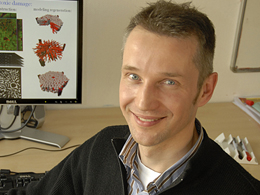Dirk Drasdo tells us about his exciting research on the liver
Date:
Changed on 12/12/2019

For many years, we have been carrying out digital simulations to guide the decisions and concepts of experiments in systems biology of multi-cell systems.
Over the last few years, our research has concentrated on the liver whereas, before, it focused on tumour growth - even though the latter remains a research subject for us. Our simulations increasingly integrate molecular processes inside each cell up to the scale of the entire organ, or even the body.
Recently, we were able to demonstrate on some significant examples that our models were capable of correctly predicting certain processes. These have been validated within the scope of liver regeneration following damage caused by drugs, such as a paracetamol overdose. The discovery of this process has therapeutic potential, as some experiments on animals by our main collaborator in toxicology at the Leibniz IfADo Institute in Germany have shown.
On the basis of this success, we have been able to obtain significant funding to transfer our models to applications in medicine, toxicology and biotechnology. The projects aim to study the processes of liver disease, liver regeneration following damage caused by drugs and after surgery and, finally, to improve therapeutic decisions and clinical therapeutic concepts.
Our mission is to integrate our research procedures and tools into the clinical workflow in order to enable the optimisation, in a prospective way, of a patient's treatment by testing it on the 'virtual abstract copy' of said patient.

The EASL-ILC Congress is a big - maybe the biggest - hepatology conference with several thousand participants. For us, it is important that clinicians are aware of the developments and opportunities in the field of digital medicine in hepatology. We can only reach or aim for goals in close collaboration with them, and if we manage to combine our expertise and our strengths.
Here, the clinic is very different to biological research as the clinician's first task is the treatment of the patient - in contrast with research. All of the procedures must therefore be integrated into their workflow, be secure, obey strict ethical rules and be financially affordable.
This creates a significant challenge for modellers. Nevertheless, we are convinced that future medicine will be - for the most part - digital, and many of our collaborating physicians from Paul Brousse hospital, the university hospitals of Heidelberg and Aix-la-Chapelle and other university hospitals support us in our mission to convince an increasing number of clinicians of the great opportunity that modelling will provide in future medicine.